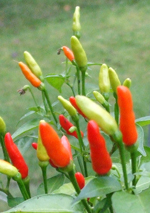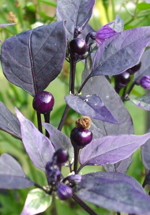Chilli Facts
Origins, Heatscale (Scoville Units) and Health Benefits

Chilli Origins
Chilli peppers have been a part of the human diet in the Americas since at least 7500 BC and come in all shapes, sizes and colours ranging from tiny pointed extremely hot, birds eye chilli to the large mild fleshy peppers like the Anaheim. Indigenous to Central and South America and the West Indies, they have been cultivated there for thousands of years before the Spanish conquest, which eventually introduced them to the rest of the world.
Mexican cooking is one of the worlds oldest cuisines, the explorers of the New World brought back the tomatoes and peppers, red hot chillis, avocados, various beans, vanilla and chocolate, these flavours were to change the flavour of Europe.

Today commercially there are many different chillis grown, and are one of the most widely cultivated crops, grown from the Far East, China, Japan, Thailand and Indonesia to India to Mexico. Some of the more commonly available fresh chillis include Jalapeño, Serrano, Poblano, Yellow Wax, Birds Eye, Habanero and more recently the super hots, Naga's, Scorpions and Moruga's are now being stocked by many stores and markets. If you cannot find the required chilli called for in a recipe try substituting with one of similar size and heat scale, or grow your own as they are as easy to grow as tomatoes especially in a greenhouse in pots.
India is the world's largest producer, consumer and exporter of chilli peppers. Guntur in Andhra Pradesh produces 30% of all the chillis produced in India, and the state of Andhra Pradesh as a whole contributes 75% of India's chilli exports.
The substances that give chilli peppers their intensity when ingested or applied is Capsaicin. When consumed, capsaicinoids bind with pain receptors in the mouth and throat that are responsible for sensing heat. Once activated by the capsaicinoids, these receptors send a message to the brain that the person has consumed something hot. The brain responds to the burning sensation by raising the heart rate, increasing perspiration and release of endorphins.

Chilli Health Benefits
Chillis are loaded with vitamin A, a potent antioxidant and boost to the immune system. As the pods mature and darken, high quantities of vitamin C are gradually replaced with beta carotene and the capsaicin levels are at their highest. Due to these capsaicin levels, some believe that eating chillis may have an extra thermic affect, temporarily speeding up the metabolic rate, hence burning off calories at a faster rate. Whatever, you certainly do sweat and actually cool down in hot climates as sweat evaporates. Your nose runs, your head clears ... you can breath! And with that extra flow of saliva, the gastric juices also flow. The alkaloids from the capsaicin stimulate the action of stomach and intestine improving the whole digestion process!

Beyond soothing gastric wonders and taste delights, the very nature of fiery capsaicin has been medicinally beneficial down through the ages and put to use for some chronic health woes. These same heat inducing properties have a cumulative effect and over time are believed to alleviate pain when used in transdermal treatments for arthritis, nerve disorders (neuralgia), shingles and severe burns ... even cluster headaches. The mucus thinning properties promote coughing and can act as an expectorant for asthmatic conditions. Other claims are boosts to the immune system due to the antioxidants, lowering cholesterol, and blood thinning properties beneficial for the heart and blood vessels.
Red chillis also contain large amounts of vitamin C and small amounts of carotene (provitamin A), with yellow and especially green chillis containing considerably lower amount of both substances. In addition, peppers are a good source of most B vitamins, and vitamin B6 in particular. They are very high in potassium, magnesium, and iron.
Variety |
Scoville Units |
| Pure Capsaicin | 15,000,000 - 16, 000,000 |
| US Police Pepper Spray | 5,000,000 |
| Carolina Reaper | 2,200,000 |
| Moruga Scorpion | 1,463,700 |
| Trinidad Scorpion "Butch T" | 1,463,700 |
| Naga Viper Pepper | 1,382,117 |
| Infinity Pepper | 1,176,182 |
| Bhut Jolokia Pepper | 1,041,427 |
| Dorset Naga Pepper | 923,000 |
| Red Savina Pepper | 350,000 - 580,000 |
| Scotch Bonnet | 100,000 - 325,000 |
| Jamaican Hot Pepper | 100,000 - 200,000 |
| Rocoto Pepper | 50,000 - 100,000 |
| Pequin Pepper | 75.000 |
| Super Chilli Pepper | 40,000 - 50,000 |
| Cayenne Pepper | 30,000 - 50,000 |
| Tabasco Pepper | 30,000 - 50,000 |
| de Arbol Pepper | 15,000 - 30,000 |
| Aji Pepper | 12,000 - 30,000 |
| Serrano Pepper | 5,000 - 23,000 |
| Hot Wax Pepper | 5,000 - 10,000 |
| Chipotle | 5,000 - 10,000 |
| Jalapeno | 2,500 - 8,000 |
| Guajilla Pepper | 2,500 - 5,000 |
| Tabasco Sauce | 2,500 |
| Pasilla Pepper | 1,000 - 2,000 |
| Ancho Pepper | 1,000 - 2,000 |
| Anaheim Pepper | 500 - 2,500 |
| Nu Mex Pepper | 500 - 1,000 |
| Santa Fe Grande Pepper | 500 - 700 |
| Pimento Pepper | 100-500 |
| Bell Pepper | 0 |
 Scoville Units
Scoville Units
Wilbur Lincoln Scoville
(January 22, 1865 – March 10, 1942)
Wilbur Scoville born in Bridgeport, Connecticut, married Cora B. Upham on September 1, 1891, had two children, Amy Augusta, born August 21, 1892 and Ruth Upham, born October 21, 1897.
In 1912 Wilbur Scoville (1845-1942) developed a method for measuring the strength of capsicum in a given pepper, which originally meant tasting a diluted version of a pepper and giving it a value. Nowadays it can be done more accurately with the help of computers to rate the peppers in Scoville units, which indicate parts per million of capsaicin. The fiery sensation of chillis is caused by capsaicin, a potent chemical that survives both cooking and freezing, but apart from the burning sensation it also triggers the brain to produce endorphins, natural painkillers that promote a sense of well being. The Scoville scale begins at zero with the mild bell peppers.
Until about year 2000 the Guiness Book of Records had the world’s hottest chilli pepper as the Red Savina Habanero. Generally these peppers range from 350,000–570,000 Scoville Units as compared with a score of 2,500–5,000 for the Jalapeno pepper. The record breaking pepper was produced by GNS Spices Inc in 1994 in Walnut, US and measured at 577,000 Scoville units. Recently however several super-hot peppers have challenged for the record. Experts at the Defence Research Laboratory in the army garrison town of Tezpur in the North-Eastern state of Assam, claimed a locally grown Naga Jolokia was nearly 50 per cent more pungent than the Red Savina Habanero at a blistering 855,000 Scoville units. Seeds of the same Naga-Bih Jolokia pepper (sometimes also called the Bhut Jolokia) cultivated at New Mexico State University have stood-up to testing and in February 2007 a specimen registering a staggering 1,001,304 Scoville heat units was officially acclaimed by the Guinness World Record as the new worlds hottest pepper. Naga Jolokia is nearly twice as hot as the previous holder, the Red Savina. This has now been overtaken with various crosses of the Trinidad Scorpion and the Naga, giving the Infinity, Naga Viper and the Trinidad Scorpion"Butch T". Heat scales are still going up, as of Nov 2013 the Carolina Reaper has just had a top scale of 2,200,000 SHU confirmed and is currently the hottest chilli pepper in the Guiness Book of records.

